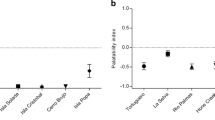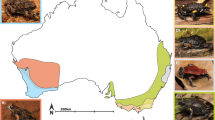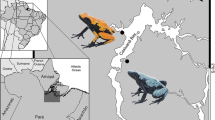Abstract
Dendrobatid poison frogs sequester alkaloids from an arthropod diet and use them in chemical defense. Alkaloid defenses vary considerably within and among species, with important consequences for the protection they can and do provide against microorganisms and predators. Most of this variation is attributed to differences in frog diet and prey availability, but emerging evidence also suggests that frogs differ in their physiological ability to sequester alkaloids. Epibatidines are one of the most geographically and phylogenetically restricted alkaloid classes in poison frogs, having been found naturally only in two genera of dendrobatids (Epipedobates and Ameerega) from Ecuador and northern Peru. To test the hypothesis that the ability to sequester epibatidine is confined to the lineages Epipedobates and Ameerega, we experimentally administered epibatidine to individuals of five species, representing three different lineages of dendrobatid poison frogs, including those known to possess (Epipedobates anthonyi) and lack (Ranitomeya variabilis, Ranitomeya imitator, Phyllobates vittatus, Dendrobates tinctorius) epibatidines in nature. All five species sequestered epibatidine; however, the percentage sequestered varied significantly across species with Epipedobates and Ranitomeya accumulating about 2.4× more than Phyllobates or Dendrobates. Our results suggest that the absence of epibatidine in certain dendrobatids is not due to the inability of these frogs to sequester epibatidine, but may instead result from differences in prey availability and/or dietary preference. Our finding of differences in the percentage of epibatidine sequestered among species points to the importance that physiological differences in sequestration play in explaining some of the alkaloid variation (including epibatidine) observed among dendrobatid poison frogs.



Similar content being viewed by others
Data availability
The dataset generated during and/or analyzed during the current study are available from the corresponding author on reasonable request.
Code availability
Not applicable.
References
Adler LS, Wink M, Distl M, Lentz AJ (2006) Leaf herbivory and nutrients increase nectar alkaloids. Ecology Letters 9:960–967
Alvarez-Buylla A, Payne CY, Vidoudez C, Trauger SA, O’Connell LA (2022) Molecular physiology of pumiliotoxin sequestration in a poison frog. PLoS ONE 17(3):e0264540
Alvarez-Buylla A, Moya-Garzon MD, Rangel AE, Tapia EE, Tanzo J, Tom Soh T, Coloma LA, Long JZ, O’Connell LA (2023) Binding and sequestration of poison frog alkaloids by a plasma globulin. bioRxiv. https://doi.org/10.1101/2022.11.22.517437
Badio B, Daly JW (1994) Epibatidine, a potent analgetic and nicotinic agonist. Mol Pharmacol 45:563–569
Basham EW, Saporito RA, González-Pinzón M, Romero-Marcucci A, Scheffers BR (2020) Chemical defenses shift with the seasonal vertical migration of a panamanian poison frog. Biotropica 53:28–37
Blum MS (ed) (1995) The toxic action of marine and terrestrial alkaloids. Alaken, Colorado
Bolton SK, Dickerson K, Saporito RA (2017) Variable alkaloid defense in the dendrobatid poison frog (Oophaga pumilio) are perceived as differences in palatability to arthropods. J Chem Ecol 43:273–289
Born M, Bongers F, Poelman EH, Sterck FJ (2010) Dry-season retreat and dietary shift of the dart-poison frog Dendrobates tinctorius (Anura: Dendrobatidae). Phyllomedusa 9:37–52
Brückmann M, Trigo JR, Foglio MA, Hartmann T (2000) Storage and metabolism of radioactively labeled pyrrolizidine alkaloids by butterflies and larvae of Mechanitis polymnia (Lepidoptera: Nymphalidae, Ithomiinae). Chemoecology 10:25–32
Caldwell JP (1996) The evolution of myrmecophagy and its correlates in poison frogs (Family Dendrobatidae). J Zool 240:75–101
Carvajal-Castro JD, Vargas-Salinas F, Casas-Cardona S, Rojas B, Santos JC (2021) Aposematism facilitates the diversification of parental care strategies in poison frogs. Sci Rep 11:19047
Caty SN, Alvarez-Buylla A, Byrd GD, Vidoudez C, Roland AB, Tapia EE, Budnik B, Trauger SA, Coloma LA, O’Connell LA (2019) Molecular physiology of chemical defenses in a poison frog. J Exp Biol 222:1–12
Clark VC, Harinantenaina L, Zeller M, Ronto W, Rocca J, Dossey AT, Rakotondravony D, Kingston DGI, Shaw C (2012) An endogenous bile acid and dietary sucrose from skin secretions of alkaloid-sequestering poison frogs. J Nat Prod 75:473–478
Cordell GA (ed) (1998) The alkaloids: chemistry and biology, vol 50. Academic Press, New York
Daly JW, Brown GB, Mensah-Dwumah M (1978) Classification of skin alkaloids from neotropical poison-dart frogs (Dendrobatidae). Toxicon 16:163–188
Daly JW, Tokuyama T, Fujiwara T, Highet RJ, Karle IL (1980) A new class of indolizidine alkaloids from the poison frog, dendrobates tricolor. X-ray analysis of 8-Hydroxy-8methyl-6-(2′-methylhexylidene)-1-azabicyclo[4.3.0]nonane. J Am Chem Soc 102:830–836
Daly JW, Myers CW, Whittaker N (1987) Further classification of skin alkaloids from neotropical poison frogs (Dendrobatidae), with a general survey of toxic/noxious substances in the amphibia. Toxicon 25:1023–1095
Daly JW, Secunda SI, Garraffo HM, Spande TF, Wisnieski A, Nishihira C, Cover JF (1992) Variability in alkaloid profiles in neotropical poison frogs (Dendrobatidae): genetic versus environmental determinants. Toxicon 30:887–898
Daly JW, Secunda S, Garraffo HM, Spande TF, Wisnieski A, Cover JF (1994) An uptake system for dietary alkaloids in poison frogs (Dendrobatidae). Toxicon 32:657–663
Daly JW (1998) Thirty years of discovering arthropod alkaloids in amphibian skin. J Nat Prod 61:162–172
Daly JW, Garraffo HM, Jian P, Spande TF, Snelling RR, Jaramillo C, Rand AS (2000a) Arthropod-frog connection: decahydroquinoline and pyrrolizidine alkaloids common to microsympatric myrmicine ants and dendrobatid frogs. J Chem Ecol 26:73–85
Daly JW, Garraffo HM, Spande TF, Decker MW, Sullivan JP, Williams M (2000b) Alkaloids from frog skin: the discovery of epibatidine and the potential for developing novel non-opioid analgesics. Nat Prod Rep 17:131–135
Daly JW, Garraffo HM, Spande TF, Clark VC, Ma J, Ziffer H, Cover JF (2003) Evidence for an enantioselective pumiliotoxin 7-hydroxylase in dendrobatid poison frogs of the genus dendrobates. Proc Natl Acad Sci 100:11092–11097
Daly JW, Spande TF, Garraffo HM (2005) Alkaloids from the amphibian skin: a tabulation of over eight-hundred compounds. J Nat Prod 68:1556–1575
Davison I, Saporito RA, Schulte LM, Summers K (2021) Piperidine alkaloids from fire ants are not sequestered by the green and black poison frog (Dendrobates auratus). Chemoecology 31:391–396
Fitch RW, Snider BB, Zhou Q, Foxman BM, Pandya AA, Yakel JL, Olson TT, Al-Muhtasib N, Xiao Y, Welch KD, Panter KE (2018) Absolute configuration and pharmacology of the poison frog alkaloid phantasmidine. J Nat Prod 81:1029–1035
Grant T, Frost DR, Caldwell JP, Gagliardo R, Haddad CFB, Kok PJR, Means DB, Noonan BP, Schargel WE, Wheeler WC (2006) Phylogenetic systematics of dart-poison frogs and their relatives (Amphibia: Athesphatanura: Dendrobatidae). Bull Am Mus Nat Hist 299:1–262
Grant T, Rada M, Anganoy-Criollo M, Batista A, Dias PH, Jeckel AM, Machado DJ, Rueda-Almonacid JV (2017) Phylogenetic systematics of dart-poison frogs and their relatives revisited (Anura: Dendrobatoidea). S Am J Herpetol 12:1–90
Gonzalez M, Palacios-Rodriguez P, Hernandez-Restrepo J, González-Santoro M, Amézquita A, Brunetti AE, Carazzone C (2021) First characterization of toxic alkaloids and volatile organic compounds (VOCs) in the cryptic dendrobatid Silverstoneia punctiventris. Front Zool 18:1–15
Guillory WX, French CM, Twomey EM, Chávez G, Prates I, von May R, De la Riva I, Lötters S, Reichle S, Serrano-Rojas SJ, Whitworth A, Brown JL (2020) Phylogenetic relationships and systematics of the Amazonian poison frog genus Ameerega using ultraconserved genomic elements. Mol Phylogenet Evol 142:106638
Hantak MM, Grant T, Reinsch S, McGinnity D, Loring M, Toyooka N, Saporito RA (2013) Dietary alkaloid sequestration in a poison frog: an experimental test of alkaloid uptake in Melanophryniscus stelzneri (Bufonidae). J Chem Ecol 39(1):1400–1406
Hartmann T, Theuring C, Witte L, Pasteels JM (2001) Sequestration, metabolism and partial synthesis of tertiary pyrrolizidine alkaloids by the neotropical leaf-beetle Platyphora boucardi. Insect Biochem Mol Biol 31:1041–1056
Hovey KJ, Seiter EM, Johnson EE, Saporito RA (2018) Sequestered alkaloid defenses in the dendrobatid poison frog Oophaga pumilio provide variable protection from microbial pathogens. J Chem Ecol 44:312–345
Jeckel AM, Saporito RA, Grant T (2015) The relationship between poison frog chemical defenses and age, body size, and sex. Front Zool 12:27–27
Jeckel AM, Matsumura K, Nishikawa K, Morimoto Y, Saporito RA, Grant T, Ifa DR (2020) Use of whole-body cryosectioning and desorption electro spray ionization mass spectrometry imaging (DESI-MSI) to visualize alkaloid distribution in poison frogs. J Mass Spectrom 55:e4520
Jeckel AM, Bolton SK, Waters KR, Antoniazzi MM, Jared C, Matsumura K, Nishikawa K, Morimoto Y, Grant T, Saporito RA (2022) Dose-dependent alkaloid sequestration and N-methylation of decahydroquinoline in poison frogs. J Exp Zool 2022:1–10
Jones TH, Blum MS, Howard RW, McDaniel CA, Fales HM, DuBois MB, Torres J (1982) Venom chemistry of ants in the genus Monomorium. J Chem Ecol 8:285–300
Jones TH, Torres JA, Spande TF, Garraffo HM, Blum MS, Snelling RR (1996) Chemistry of venom alkaloids in some Solenopsis (Diplorhoptrum) species from Puerto Rico. J Chem Ecol 22:1221–1236
Lapins M, Arvidsson S, Lampa S, Berg A, Schaal W, Alvarsson J, Spiuth O (2018) A confidence predictor for logD using conformal regression and a support-vector machine. J Cheminform 10:1–10
Lawrence JP, Rojas B, Fouquet A, Mappes J, Blanchette A, Saporito RA, Bosque RJ, Courtois EA, Noonan B (2019) Weak warning signals can exist in the absence of gene flow. Proc Natl Acad Sci USA 116(38):19037–19045
Lawrence JP, Rojas B, Blanchette A, Saporito RA, Mappes J, Fouquet A, Noonan BP (2023) Linking predator responses to alkaloid variability in poison frogs. J Chem Ecol 49:195–204
Leo A, Hansch C, Elkins D (1971) Partition coefficients and their uses. Chem Rev 71:525–616
Lipinski CA, Lombardo F, Dominy BW, Feeney PJ (1997) Experimental and computational approaches to estimate solubility and permeability in drug discovery and development settings. Adv Drug Deliv Rev 23:3–25
Márquez R, Ramírez-Castañeda V, Amézquita A (2019) Does batrachotoxin autoresistance coevolve with toxicity in Phyllobates poison-dart frogs? Evolution 73:390–400
Marin CM, Molina-Zuluaga C, Restrepo A, Cano E, Daza JM (2018) A new species of Leucostethus (Anura: Dendrobatidae) from the eastern versant of the Central Cordillera of Colombia and the phylogenetic status of Colostethus fraterdanieli. Zootaxa 4461:359
McGugan JR, Byrd GD, Roland AB, Caty SN, Kabir N, Tapia EE, Trauger SA, Coloma LA, O’Connell LA (2016) Ant and mite diversity drives toxin variation in the little devil poison frog. J Chem Ecol 42:537–551
Mebs D, Alvarez JV, Pogoda W, Toennes SW, Köhler G (2014) Poor alkaloid sequestration by arrow poison frogs of the genus Phyllobates from Costa Rica. Toxicon 80:73–77
Mina AE, Ponti AK, Woodcraft NL, Johnson EE, Saporito RA (2015) Variation in alkaloid-based microbial defenses of the dendrobatid poison frog Oophaga pumilo. Chemoecology 25:169–178
Moskowitz NA, Dorritie B, Fay T, Nieves OC, Vidoudez C, Rindge C, Latin 2017 Biology Class, Masconomet 2017 Biotechnology Class, Fischer EK, Trauger SA, Coloma LA, Donoso DA, O’Connell LA (2020) Land use impacts poison frog chemical defenses through changes in leaf litter ant communities. Neotrop Biodivers 6:75–87
Murray EM, Bolton SK, Berg T, Saporito RA (2016) Arthropod predation in a dendrobatid poison frog: does frog life stage matter? Zoology 119:169–174
Nishida R (2002) Sequestration of defensive substances from plants by Lepidoptera. Annu Rev Entomol 47:57–92
O’Connell LA, LS50: Integrated Science Laboratory Course, O’Connell JD, Paulo JA, Trauger SA, Gygi SP, Murray AW (2021) Rapid toxin sequestration modifies poison frog physiology. J Exp Biol 224:1–8
Opitz SEW, Müller C (2009) Plant chemistry and insect sequestration. Chemoecology 19:117–154
Pasteels JM, Hartmann T (2004) Sequestration of pyrrolizidine alkaloids in Oreina and Platyphora leaf beetles: physiological, ecological and evolutionary aspects. In: Jolivet P, Santiago-Blay J, Schmitt M (eds) New developments in the biology of chrysomelidae. Brill, Leiden, pp 677–691
R Core Team (2021) R: a language and environment for statistical computing. R Foundation for Statistical Computing, Vienna
Roberts MF, Wink M (eds) (1998) Alkaloids: Biochemistry, ecology, and medicinal applications. Plenum Press, New York
Ruxton GD, Sherratt TN, Speed MP (2004) Avoiding attack: the evolutionary ecology of crypsis, warning signals and mimicry. Oxford University Press, Oxford
Sanchez E, Rodriguez A, Grau JH, Lötters S, Künzel S, Saporito RA, Ringler E, Schulz S, Valero KCW, Vences M (2019) Transcriptomic signatures of experimental alkaloid consumption in a poison frog. Genes 10:1–14
Santos JC, Coloma LA, Cannatella DC (2003) Multiple recurring origins of aposematism and diet specialization in poison frogs. Proc Natl Acad Sci 100:12792–12797
Santos JC, Cannatella DC (2011) Phenotypic integration emerges from aposematism and scale in poison frogs. Proc Natl Acad Sci 108:6175–6180
Santos JC, Tarvin RD, O’Connell LA (2016) A review of chemical defense in poison frogs (Dendrobatidae): ecology, pharmacokinetics, and autoresistance. Chem Signal Vertebr 13:305–337
Saporito RA, Donnelly MA, Norton R, Garraffo HM, Spande TF, Daly JW (2007a) Oribatid mites as a major dietary source for alkaloids in poison frogs. Proc Natl Acad Sci 104:8885–8890
Saporito RA, Donnelly MA, Jain P, Garraffo HM, Spande TF, Daly JW (2007b) Spatial and temporal patterns of alkaloid variation in the poison frog Oophaga pumilio in Costa Rica and Panama over 30 years. Toxicon 50:757–778
Saporito RA, Spande TF, Garraffo HM, Donnelly MA (2009) Arthropod alkaloids in poison frogs: a review of the ‘dietary hypothesis.’ Heterocycles 79:277–297
Saporito RA, Norton RA, Andriamaharavo NR, Garraffo HM, Spande TF (2011) Alkaloids in the mite Scheloribates laevigatus: Further alkaloids common to oribatid mites and poison frogs. J Chem Ecol 37:213–218
Saporito RA, Donnelly MA, Spande TF, Garraffo HM (2012) A review of chemical ecology in poison frogs. Chemoecology 22:159–168
Saporito RA, Norton RA, Garraffo HM, Spande TF (2015) Taxonomic distribution of defensive alkaloids in Nearctic oribatid mites (Acari, Oribatida). Exp Appl Acarol 67:317–333
Saporito RA, Russell MW, Richards-Zawacki CL, Dugas MB (2019) Experimental evidence of maternal provisioning of alkaloid defenses in a dendrobatid frog. Toxicon 161:40–43
Schulte LM, Saporito RA, Davison I, Summers K (2016) The palatability of poison frogs: do alkaloids make the difference? Biotropica 49(1):23–26
Spande TF, Garraffo HM, Edwards MW, Yeh HJC, Pannell L, Daly JW (1992) Epibatidine: a novel (Chloropyridyl) azabicycloheptane with potent analgesic activity from an Ecuadoran poison frog. J Am Chem Soc 114:3475–3478
Summers K, Tumulty J (2014) Parental care, sexual selection, and mating systems in neotropical poison frogs. In: Machado G, Macedo RD (eds) Sexual selection. Perspectives and models from the neotropics. Academic Press, London, pp 289–320
Takada W, Sakata T, Shimano S, Enami Y, Mori N, Nishida R, Kuwahara Y (2005) Scheloribatid mites as the source of pumiliotoxins in dendrobatid frogs. J Chem Ecol 31:2403–2415
Tarvin RD, Santos JC, O’Connell LA, Zakon HH, Cannatella DC (2016) Convergent substitutions in a sodium channel suggest multiple origins of toxin resistance in poison frogs. Mol Biol Evol 33:1068–1080
Tarvin RD, Borghese CM, Sachs W, Santos JC, Lu Y, O’Connell LA, Cannatella DC, Harris RA, Zakon HH (2017) Interacting amino acid replacements allow poison frogs to evolve epibatidine resistance. Science 357:1261–1266
Trigo JR (2011) Effects of pyrrolizidine alkaloids through different trophic levels. Phytochem Rev 10:83–98
Wink M (1988) Plant breeding: importance of plant secondary metabolites for protection against pathogens and herbivores. Theor Appl Genet 75:225–233
Yang Y, Richards-Zawacki CL, Devar A, Dugas MB (2016) Poison frog color morphs express assortative mate preferences in allopatry but not sympatry. Evolution 70(12):2778–2788
Acknowledgements
We thank N. Savastano for her care of the frogs used in the study, and V. DelSignore for his assistance with the feeding experiments. We also thank the editor and two anonymous reviewers for helping to improve the quality of this manuscript. All of the research protocols were approved by the Institutional Animal Care and Use Committees of John Carroll University (#2102 for “Sequestered chemical defenses in poison frogs”). TG was supported by the São Paulo Research Foundation (FAPESP Proc. 2018/15425-0) and Brazilian National Council for Scientific and Technological Development (CNPq Proc. 314480/2021-8).
Funding
TG was supported by the São Paulo Research Foundation (FAPESP Proc. 2018/15425-0) and Brazilian National Council for Scientific and Technological Development (CNPq Proc. 314480/2021-8).
Author information
Authors and Affiliations
Contributions
KRW and RAS conceived, designed, and carried out the experiments and performed the chemical analyses. RAS and MBD performed the statistical analysis. MBD bred and raised the R. variabilis, R. imitator, and P. vittatus. KRW wrote the first draft of the manuscript, and all authors participated in the revision of this draft. All authors read and approved the final manuscript.
Corresponding author
Ethics declarations
Conflict of interest
Not applicable.
Ethics approval
All of the research protocols were approved by the Institutional Animal Care and Use Committees of John Carroll University (#2102 for “Sequestered chemical defenses in poison frogs”).
Consent to participate
All co-authors have consented to participate in the research and manuscript publication.
Consent for publication
All co-authors have approved the manuscript for publication.
Additional information
Publisher's Note
Springer Nature remains neutral with regard to jurisdictional claims in published maps and institutional affiliations.
Rights and permissions
Springer Nature or its licensor (e.g. a society or other partner) holds exclusive rights to this article under a publishing agreement with the author(s) or other rightsholder(s); author self-archiving of the accepted manuscript version of this article is solely governed by the terms of such publishing agreement and applicable law.
About this article
Cite this article
Waters, K.R., Dugas, M.B., Grant, T. et al. The ability to sequester the alkaloid epibatidine is widespread among dendrobatid poison frogs. Evol Ecol (2023). https://doi.org/10.1007/s10682-023-10260-6
Received:
Accepted:
Published:
DOI: https://doi.org/10.1007/s10682-023-10260-6




